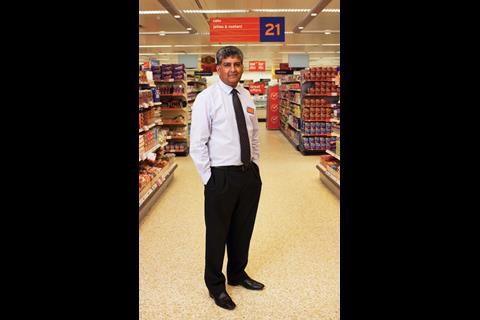Supermarket giant Sainsbury’s plans to spend more than £700m annually on growing its space by 10% over the next three years. But if you want to impress commercial director Neil Sachdev, you’ll need to know your way around the shop floor.
Neil Sachdev is standing in a supermarket aisle being photographed, or at least trying to be. As the photographer tells the commercial director of Sainbury’s how to stand, an elderly lady with a trolley trundles into the cake aisle, oblivious to what’s going on. She then stays stock still for five minutes, seemingly unable to decide between the Madeira and the syrup cake.
After the photographer has tried shooting from different angles to cut her out, while simultaneously stifling his giggles, she turns around: “Ooh. Sorry. Am I in the way?”
“Of course not, take as much time as you like,” says Sachdev. “If you’re not buying food from us, then I’m out of a job.”
This is Sachdev all over. He’s a retail man through and through, and he believes that the customer is always right.
Sachdev joined Sainsbury’s 14 months ago to run its building projects, having spent the previous 28 years at Tesco, where he started his career as a store manager. His experience on the shop floor defines his approach and he asks everyone he works with to spend a week working in a supermarket – so that they get it too. He says: ”It amazes me how many people don’t do that sort of thing. How many construction project managers go and work next to a brickie and say: ’I’m going to put up a brick wall with you’?”
Working a week on the shop floor to impress Sachdev could be well worth your while, because he’s about to spend a lot of money on construction projects – between £700-800m a year for the next three years. Sainsbury’s plans to grow its space by around 10% during this period. Sachdev says this means an increase of between 65,030m2 and 92,900m2 by 2010. He’ll be opening 10-15 new stores and extending up to 24 existing stores every year.
It’s all part of the ambition to knock Tesco off the number-one spot: “When I was growing up Sainsbury’s was the number-one retailer. I want to make that happen again. We’re on the way: we’ve had 13 quarters now of like-for-like growth. That has never been achieved by Sainsbury’s before.” Sachdev says Sainsbury’s has the broadest range of stores of any retailer. “We’ll build anything from 3,000ft2 to up to 100,000ft2.” He is less candid about plans beyond the next three years, saying only that he’s aiming for at least the same rate of expansion.
His reticence is perhaps understandable considering that last month the Competition Commission wrapped up its investigation into supermarkets. The two-year probe looked at the practice of “land banking”, where supermarkets buy up sites in areas where they already have a presence but don’t actually develop them, allegedly to prevent rivals from getting the land.
When I take the issue up with a Sainsbury’s PR person later, she tells me that the company does not hold a land bank. Although it holds land for which it has not applied for planning, it is “in the process of consultations about potential new development” on each of these sites.
The commission has also recommended that all retailers trying to open new branches must pass a competition test to see if another of their stores within a certain area would make the local market uncompetitive. The PR says Sainsbury’s “agrees with this and it would provide a better deal for local customers”. It seems reasonable to assume it might also see it as an opportunity to claw some ground back from Tesco.
In the meantime, however, the company is cracking on with its three-year building programme. It looks to be a relatively enlightened client, using, for example, “lean” production methods. These include a consolidation centre in west London which has been set up to improve logistics on sites in the South-east.
More consolidation centres are planned and these too have been influenced by Sainsbury’s’ obsession with customer service. Building materials are distributed and delivered just in time rather than hanging around on site for long stretches, just as food is distributed via central warehouses.
I don’t intend to have too cosy a relationship with anyone because we need some tension
Neil Sachdev, Sainsbury’s
Sachdev says: “The construction industry is overly complex and cumbersome at this sort of thing. As food retailers we realise that ultimately it’s about getting things somewhere in the simplest way.”
Sainsbury’s also builds off site, another “lean” technique. For instance, at a store in Frome, Somerset, a 929m2 extension was added after being built off site and was open for business within 12 weeks, as opposed to the traditional 22 weeks. “The stores always stay open while extensions are being built,” says Sachdev. “If we close, where will customers get their food?”
Sustainability is another key theme to the expansion plan. Sachdev says reclaim technology, which recaptures heat and cold from fridges for heating and air-conditioning, is becoming standard in a lot of stores. More and more glazing is being used to provide natural light and the most energy-efficient artificial lighting possible is being used.
The Greenwich store is the firm’s green flagship, boasting geo-thermals that use natural heat from the ground. And the building process itself is being made greener. Sainsbury’s says it has exceeded a target it set itself to recycle 100% of construction waste on 60% of sites by March this year, with 80% of sites now doing so.
So contractors and consultants that work for Sainsbury’s will have to be up on sustainability, but what else? The company uses 12 main contractors, which are on a partnership framework. Sachdev has them on design-and-build contracts. He says: “The way we’re constructing our stores will mean we’re going to have a price list for every size of store I build. So I’ll know how much the steel costs because I’m procuring it. I’ll know what the shelving costs because I’m procuring it. I know how much the groundworks are going to be, and so on.” This means the only thing left to price up is labour. “And we’ll know what the standard costs of fees are. So the only negotiation over those will take place once a year or once every two years. We’ll talk about what profit we would like to make, agree a number and do a deal.”
He says: “Eventually a number of jobs should just be awarded. We know what the price structure is and the rest we’ll tender, just to test the market to make sure we’re not out of keel with what’s going on. And that makes everyone very, very honest. And more importantly it keeps us competitive as well.”
However, Sachdev also works with contractors not on the framework. “I don’t intend to have too cosy a relationship with anyone because we need some tension. One thing I’m very clear on is that my door is always open to any other contractor who wants to work with us.”
What about in-house construction personnel? “The key people on my team are my customers …”
Right … “No, it’s really important. I’ll always start by sitting down with about 200 customers before we start working on a store and ask them what they want. This is what we’re working on, how is this going to work for you? After that we go to colleagues and say: ‘How can we make this as simple as possible to work in?’ Then my team come in.”
It’s an approach that those who do work for the company appreciate: “Sainsbury’s talk to people more and get the community on board rather than just barnstorming in. That’s quite refreshing because some clients are just bullies,” says Laurie Chetwood, founder of architect Chetwood Associates.
After 28 years with Tesco, does it seem strange to Sachdev to be working for one of its main rivals? No, as long as he’s serving the customer, he’s happy. “It’s the obsession I see with the customers that I really like – it’s about how I can make it work for the customer all the time. That’s the exciting bit.”
Who’s on Sainsbury’s’ framework?
Contractors
Tier 1 (spend of over £50m)
- RG Group
- Bowmer & Kirkland
- Kier
- Costain
- Pearce
- Longcross
Tier 2 (spend of under £50m) - Midas
- Uplands
- Basebuild
- Dudley’s
- Styles & Wood
- Wates
Architects - CHQ Partnership
- Chetwood Associates
- ADF
- Stride Treglown
QSs - Riley Consulting
- EC Harris
- Mace
What it takes to work for Sainsbury’s
What impresses you in a prospective contractor?
“If you can be innovative and help us drive our agenda, we’ll talk to you very quickly. Our agenda is based on what we are doing to respect the environment and about caring for people in the stores. Do you source with integrity? Are you going to understand what our customer proposition is? Do you know what we’re trying to do? And if all of that comes through from a contractor, I would find it very hard not to work with them.”
What puts you off?
“Clearly everyone wants to grow their business but far too often I come across contractors making claims that are far beyond their immediate reach. I would rather work with people who are honest about what they can do, rather than what they would like to do. I never want to be working with a contractor who’s likely to fail. Because I don’t want them to fail, I want them to succeed with me. Another thing I see over and over again is too many contractors without enough succession planning or people training. They’re not developing the youth that are coming through; they’re just waiting to poach off someone else.”
Neil Sachdev on working with construction
“The construction industry should do more to understand the client. By the client I don’t mean me, I’m talking about the customers I serve. One of the things I struggle with is that they forget they’re building buildings for people rather than just buildings.”
“Bring more innovation, try something different every time. We are shopkeepers and we rely on the construction industry, as our specialists, to help us achieve our goals.”
“How do we get to a place where the price I get first time round is the right price? I’ve yet to be given a single price by a construction company that is right. It always turns out lower than where we start at. They always agree with me about how it could be lower and why it should be lower. So why don’t we come in with that low price to start with so we all know where we are?”
Postscript
www.building.co.uk/clients





























No comments yet